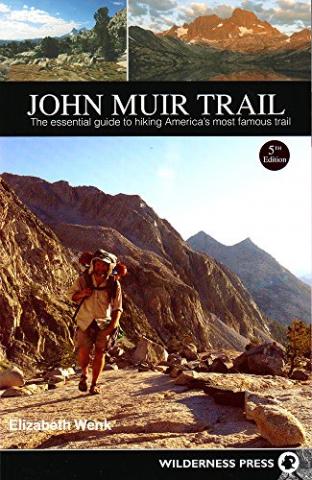By now, it's getting a bit late to be hiking the entire John Muir Trail. In fact, you should be nearing the end of your trek. But if you've wondered about taking on that long-distance walk next year or the year after, there's a good book you should read.
Elizabeth Wenk's update for the 5th edition of John Muir Trail, The Essential Guide to Hiking America's Most Famous Trail (a title some Appalachain Trail fans might quibble with) provides you with section maps, side trails that will take you into towns for food-drop pickups or a shower, a list of available campsites with some description, even GPS coordinates for locating food storage boxes to keep the bears out of your meals.
Wenk, you might recall, also wrote One Best Hike: Grand Canyon, and she brings her diligent approach to the John Muir guidebook. To handle the update, she set out on a month-long walk, both to check out several short stretches of the trail that had been rerouted since the 4th edition arrived back in 2007 and to glean insights from her own experience and from hikers she encountered.
Technology thwarted her best efforts, a bit, as her GPS unit became corrupted and ate some of the data she intended to use for her topo maps. Still, with help from others, she was able to replace the missing data. Yet her experience with technology, and the small maps within the text, beg the question of how best to utilize the information. Do you make copies of the maps to carry with you, take the entire book, or wish there were a portal where you could download the maps and waypoints onto your own GPS unit...and hope it doesn't fail you.
But really, the purpose of such a guide, and the joy to be derived from it, is to spend the winter months poring through its chapters and gleaning not only information that will enable you to properly prepare and execute your own trek of the John Muir Trail that passes through parts of Yosemite, Kings Canyon and Sequoia national parks, as well as Devils Postpile National Monument, but to head into it filled with enthusiasm and excitement for crossing the Range of Light on foot.
The book is aimed at all hikers: hikers completing the entire JMT in a single trip, as well as those walking a shorter section of the trail; hikers completing the route in 10 days and those taking a month. As a result, the guide does not include suggested daily itineraries, as each person or group has a different pace, different desires for layover days, lazy afternoons around camp, or detours to nearby peaks or lake basins. Instead, ths guide is aimed to provide you with background knowledge and let you design your own trip, in advance or as you walk. The book provides information on distances, lateral trails, established camping locations, notable stream crossings, long climbs, especially splendid lakes, detours up worthy peaks, and a bit of natural history to encourage you to gaze at your surroundings. From there, you design the itinerary that best suits you.
Additional resources that might prove helpful in planning your trip are:







